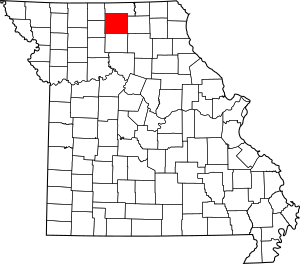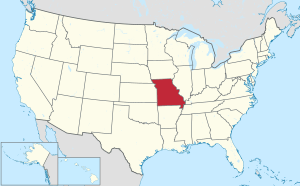Sullivan County, Missouri facts for kids
Quick facts for kids
Sullivan County
|
|
|---|---|

Sullivan County Courthouse in Milan
|
|

Location within the U.S. state of Missouri
|
|
 Missouri's location within the U.S. |
|
| Country | |
| State | |
| Founded | 1843 (created) 1845 (organized) |
| Named for | John Sullivan |
| Seat | Milan |
| Largest city | Milan |
| Area | |
| • Total | 652 sq mi (1,690 km2) |
| • Land | 648 sq mi (1,680 km2) |
| • Water | 3.5 sq mi (9 km2) 0.5% |
| Population
(2020)
|
|
| • Total | 5,999 |
| • Density | 9.201/sq mi (3.5525/km2) |
| Time zone | UTC−6 (Central) |
| • Summer (DST) | UTC−5 (CDT) |
| Congressional district | 6th |
Sullivan County is a county in the northern part of Missouri, a state in the United States. In 2020, about 5,999 people lived there. The main town and county seat is Milan. The county was officially formed on February 14, 1845. It was named after Major General John Sullivan, a hero from the American Revolutionary War.
Contents
History of Sullivan County
How Sullivan County Started
In 1682, a French explorer named René-Robert Cavelier, Sieur de la Salle claimed a large area of land for France. This land was west of the Mississippi River and included what is now Sullivan County. Later, in 1803, the United States bought this land from France in a deal called the Louisiana Purchase.
Native American groups like the Sac, Meskwaki (Fox), and Iowa nations lived here. In 1824, they signed agreements to give their land to the U.S. government.
First Settlers and Early Towns
The first permanent non-Native American settlers arrived in 1836. They were Dr. Jacob Holland and his son, Robert W. Holland. They built their homes near a place called Scottsville. Soon, many other pioneers from states like Ohio and Kentucky moved to the area. They started farms and small businesses in places like Milan, Yellow Creek, and Jacksonville.
In 1842, the Missouri state government first marked out the county's borders. They called it Highland County. But there weren't enough people living there yet for it to be a fully organized county. So, it was managed by Linn County for a while.
By 1844, more people had moved in. On February 14, 1845, the county was officially organized. It was also renamed Sullivan County, honoring General John Sullivan from the American Revolutionary War.
Growth of Milan and Other Towns
The town of Milan was started in 1845. It was chosen as the county seat because it was in the middle of the county. The first courthouse was built in 1847. Later, in 1857, a new brick courthouse was built. This building was destroyed by fire in 1908. The current courthouse was built in 1938.
Other towns also grew in Sullivan County during these early years. These included Greencastle (1857), Newtown (1858), Pollock (1873), and Green City (1880).
Sullivan County During the Civil War
During the American Civil War (1861–1865), there was a Union Army base in Milan. Many people from Sullivan County fought in the war. They joined both Union and Confederate groups. Soldiers from the county fought in big battles like the Battle of Shiloh and the Battle of Atlanta. Most of the fighting within the county itself was from small groups of fighters called bushwhackers.
Railroads and Farming Life
The arrival of railroads in the 1870s helped Sullivan County grow. Train lines were built through the county, crossing in Milan. This made Milan an important place for shipping goods. More railroads were built, connecting towns like Newtown and Harris. These railroads helped farmers get their products to other places.
By 1900, over 20,000 people lived in Sullivan County. But after that, the number of people and businesses slowly went down. Today, Sullivan County is still mostly farmland. Farmers grow corn and grains, and raise chickens, livestock, and dairy cows.
Geography of Sullivan County
Sullivan County covers about 652 square miles. Most of this is land, with a small amount of water.
Rivers and Highest Points
The main waterways in Sullivan County are Medicine, Locust, East Locust, Yellow, and Spring Creeks. The highest point in the county is about 1,060 feet above sea level. This is near the northern border with Putnam County. The lowest point is about 740 feet above sea level, where Locust Creek leaves the county on its southern border.
Neighboring Counties
- Putnam County (north)
- Adair County (east)
- Linn County (south)
- Grundy County (southwest)
- Mercer County (northwest)
Main Roads in Sullivan County
People of Sullivan County
| Historical population | |||
|---|---|---|---|
| Census | Pop. | %± | |
| 1850 | 2,983 | — | |
| 1860 | 9,108 | 205.3% | |
| 1870 | 11,907 | 30.7% | |
| 1880 | 16,569 | 39.2% | |
| 1890 | 19,000 | 14.7% | |
| 1900 | 20,282 | 6.7% | |
| 1910 | 18,598 | −8.3% | |
| 1920 | 17,781 | −4.4% | |
| 1930 | 15,212 | −14.4% | |
| 1940 | 13,701 | −9.9% | |
| 1950 | 11,299 | −17.5% | |
| 1960 | 8,783 | −22.3% | |
| 1970 | 7,572 | −13.8% | |
| 1980 | 7,434 | −1.8% | |
| 1990 | 6,326 | −14.9% | |
| 2000 | 7,219 | 14.1% | |
| 2010 | 6,714 | −7.0% | |
| 2020 | 5,999 | −10.6% | |
| U.S. Decennial Census 1790-1960 1900-1990 1990-2000 2010-2015 |
|||
In 2010, there were 6,714 people living in Sullivan County. About 88.73% of the people were White. About 18.59% of the population was Hispanic or Latino. This makes Sullivan County the county with the most Hispanic/Latino people in Missouri.
The average age of people in the county was 39 years old. About 25% of the population was under 18 years old.
2020 Census Information
| Race | Number | Percentage |
|---|---|---|
| White (not Hispanic) | 4,507 | 75.13% |
| Black or African American (not Hispanic) | 208 | 3.47% |
| Native American (not Hispanic) | 26 | 0.43% |
| Asian (not Hispanic) | 29 | 0.48% |
| Pacific Islander (not Hispanic) | 1 | 0.02% |
| Other/Mixed (not Hispanic) | 174 | 3% |
| Hispanic or Latino | 1,054 | 17.6% |
Education in Sullivan County
Public Schools
- Green City R-I School District – Green City
- Green City Elementary School (Grades PK-6)
- Green City High School (Grades 7-12)
- Milan C-2 School District – Milan
- Milan Elementary School (Grades PK-4)
- Milan Middle School (Grades 5-8)
- Milan High School (Grades 9-12)
- Newtown-Harris R-III School District – Newtown
- Newtown-Harris Elementary School (Grades PK-6)
- Newtown-Harris High School (Grades 7-12)
Public Library
- Sullivan County Library
Communities in Sullivan County
Cities
- Browning (partly in Linn County)
- Green City
- Greencastle
- Harris
- Milan (county seat)
- Newtown
Villages
Census-Designated Place
Other Communities (Unincorporated)
Notable People from Sullivan County
- Gene Bartow - A famous college basketball coach and NBA executive. He is in the Hall of Fame for college basketball.
- Bud Houser - Won many Olympic medals in track and field events. He was born in Winigan.
Images for kids
See also
 In Spanish: Condado de Sullivan (Misuri) para niños
In Spanish: Condado de Sullivan (Misuri) para niños


